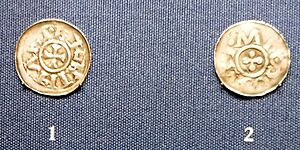Eckard I, Margrave of Meissen facts for kids
Quick facts for kids
Eckard I
|
|
|---|---|
| Margrave of Meissen | |

Coins minted during the reign of Eckard I
|
|
| Reign | 985–1002 |
| Born | c. 960 |
| Died | 30 April 1002 Pöhlde Abbey |
| Buried | Gerbstedt Abbey |
| Noble family | Ekkehardiner |
| Spouse(s) | Schwanehilde (Suanhild) |
| Father | Gunther of Merseburg |
Eckard I (also known as Ekkehard) was an important leader who lived from about 960 to 1002. He was the Margrave of Meissen from 985 until he died. A margrave was a powerful ruler in charge of a border region, like a duke or count. Eckard was the first margrave from the Ekkehardinger family, which ruled over Meissen for many years.
Contents
Eckard's Life and Role
Eckard came from a noble family in Thuringia, a region in Germany. He was the oldest son of Margrave Gunther of Merseburg. In 976, Eckard and his father had to leave their home for a few years.
Supporting the Emperor
In 982, Eckard joined a battle in Italy against the Emirate of Sicily. Sadly, his father, Gunther, was killed in this battle. When Emperor Otto II died in 983, his son, Otto III, was still very young. Eckard strongly supported young King Otto III.
In 984, at a big meeting called a Hoftag (like a royal court assembly), Eckard worked with other German princes. They helped free the four-year-old King Otto III from his cousin, Duke Henry II of Bavaria, who wanted to be king instead.
Becoming Margrave of Meissen
In 985, King Otto III chose Eckard to become the new Margrave of Meissen. This happened after the Saxons had lost battles against the Slavic Lutici tribes. Eckard was a key supporter of the king and his mother, Empress Theophanu.
His main job was to protect the lands of the Milceni people. He also had to keep an eye on the nearby Polish and Bohemian regions. The Duke of Bohemia, Boleslaus II, had taken over a castle called Albrechtsburg. But Eckard's forces made him leave by 987.
Leading and Fighting
Later, the important leaders of Thuringia chose Eckard to be their Duke. This showed that people believed in choosing their leaders. In 990, Duke Boleslaus II of Bohemia teamed up with the Lutici tribes and went to war with Mieszko I of Poland. Margrave Eckard led the combined German and Polish armies against Bohemia.
Eckard also helped a bishop named Thiadric, Bishop of Prague get his position back after he was forced out by Boleslaus II. In 996, Eckard went with Otto III to Rome, where Otto was crowned Holy Roman Emperor. Two years later, in 998, Eckard's soldiers helped stop a rebellion led by Crescentius the Younger by attacking Castel Sant'Angelo.
Emperor Otto III liked Eckard very much. He rewarded Eckard by changing many of his "benefices" (lands given for service) into "proprietas" (lands owned outright).
Aiming for the Crown
When Emperor Otto III died in 1002 without children, the German princes met to choose a new king. Eckard even tried to become king himself. The main candidate was Henry of Bavaria, Otto III's cousin, but many nobles didn't want him.
Eckard was the most obvious choice from the Saxon region. The nobles agreed to meet again later and not support anyone yet. At the next meeting, Henry managed to get enough support to be chosen as king.
Even so, Eckard was still very respected. He was honored like royalty by some bishops. However, just a few days later, he was killed by some of his Saxon rivals in Pöhlde. Among those rivals were Count Henry III of Stade and Count Siegfried II of Northeim.
Burial and Legacy
Eckard was first buried at his family's castle. Later, in 1028, his body was moved to a monastery in Naumburg. Bishop Thietmar of Merseburg wrote about him, calling him "the glory of the kingdom, the comfort of the homeland, a friend to his people, a terror to his enemies, and perfect in every way."
After Eckard's death, there was a disagreement over who should rule Meissen. Duke Bolesław I Chrobry of Poland, who had supported Eckard, claimed it. The new King Henry gave Bolesław some land, but Meissen itself was given to Gunzelin, Eckard's younger brother.
Family Life
Eckard was married to Schwanehilde (Suanhild). She was the daughter of Hermann Billung, a powerful leader in Saxony. Schwanehilde died in 1014. She was Eckard's second wife and had been married before to another margrave.
Eckard and Schwanehilde had seven children:
- Liutgard (died 1012), who married Margrave Werner of the Northern March.
- Herman I, Margrave of Meissen (died 1038), who married Regelinda, the daughter of King Bolesław I Chrobry of Poland.
- Eckard II, Margrave of Meissen (died 1046), who married Uta.
- Gunther (died 1025), who became the Archbishop of Salzburg.
- Eilward (died 1023), who became the Bishop of Meissen.
- Matilda, who married Dietrich II, Margrave of Lower Lusatia.
- Oda (died after 1018), who married King Bolesław I Chrobry of Poland.
| Preceded by Rikdag |
Margrave of Meissen 985–1002 |
Succeeded by Gunzelin |

